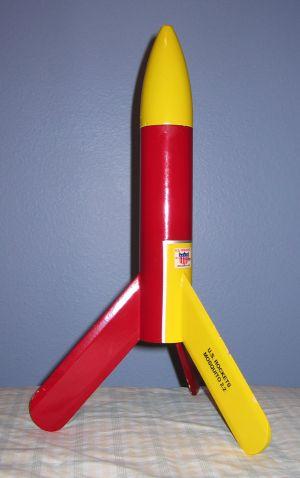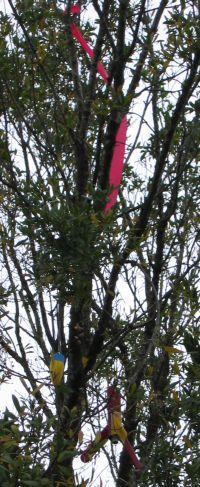| Construction Rating: | starstarstarstarstar_border |
| Flight Rating: | starstarstarstarstar |
| Overall Rating: | starstarstarstarstar |
| Diameter: | 2.25 inches |
| Length: | 17.50 inches |
| Manufacturer: | U.S. Rockets  |
| Style: | Upscale |

Brief:
The US Rockets (USR) Mosquito 2.2 is an easy to build ~4.5x upscale of the
perennial Estes kit. (The 2.2 refers to the diameter of the airframe in
inches.) While still lightweight--less than 5oz completed--it does come back on
streamer recovery. It flies on smaller 29mm motors and even comes with an
adapter so 24mm motors can be used.
Construction:
The kit includes:
- 1 2.25" ogive balsa nose cone
- 1 9" x 2.25" body tube
- 2 birch ply centering rings
- 1 4" long 29mm motor tube
- 1 screw eye
- 1 3-fold paper shock cord mount
- 1 60" x 1/4" elastic shock cord
- 3 1/4" balsa fins
- 1 1/4" launch lugs
- 1 60" x 3" plastic streamer
- 1 24mm motor adapter kit
- Decals
- Instruction manual
- Advanced Information Report (AIR) #1 -- Motor Installation
After several recent challenging rocket builds, I needed to build something that had more instant gratification and kept to basic build techniques. The U.S. Rockets Mosquito proved to be a more than worthwhile distraction. With so few parts and pre-cut surface mount fins, perhaps the greatest challenge was sanding a nice even taper on the long leading and trailing edges of the fins. A sanding block with 150 grit sandpaper still made reasonably short work of this task. Using masking tape (or alternately, drawing lines) on the fins assured an even taper on all sides of the fins.
The centering rings were glued and filleted near the ends of the motor mount tube with yellow wood glue (aliphatic resin). Yellow wood glue was in fact used for the entire build. While the motor mount was drying, I used the marking guide in the instructions and my Estes Fin Alignment tool to mark the fins and launch lug lines the length of the short body tube.
Allowing the motor mount a few more minutes to dry, I inserted the screw eye into the base of the nose cone, twisted it back out, and then squeezed a small amount of polyurethane glue into the hole before reinserting the screw eye. Then I used a X-Acto knife to cut the 2" long launch lug in half at a 45 degree angle. Lastly I glued the fins onto the body tube with the trailing edge even with the aft end of the tube using the double glue method (lightly glue, press the fin onto the body tube, pull it away, wait a minute, apply more glue on fin, place the fin back on the tube, and allow to dry fully). I did that for each of the 3 fins keeping a close eye on their alignment. The launch lugs were tacked on the tube at the aft end and 6" up. A couple layers of fillets had the fins and launch lugs firmly attached.
With the fins and motor mount dry, I put a generous amount of glue inside the aft end of the body tube and slide the motor mount up until the aft end of the motor tube was flush with the aft end of the body tube. I set it aside and let it dry overnight.
 I waited
until after all of the painting had been done to install the shock cord, which
uses the familiar tri-fold paper mount inside the airframe and ties to the
screw eye. To make the streamer portable, I tied a snap swivel onto one end. A
small loop was tied in the shock cord to clip the streamer to.
I waited
until after all of the painting had been done to install the shock cord, which
uses the familiar tri-fold paper mount inside the airframe and ties to the
screw eye. To make the streamer portable, I tied a snap swivel onto one end. A
small loop was tied in the shock cord to clip the streamer to.
I did not bother to assemble the 24mm motor adapter. This is one of many USR kits I've built to date that already use the same adapter. I'll save the tubes for another project...
Finishing:
No surprises here. The nose cone was on the rough side but a couple coats of
Elmer's Fill 'n' Finish along with some sanding had it smoothed out in no time.
The fins received a similar treatment but only needed one coat of FnF. USR
tubes are so smooth. I didn't have to fill any spirals and jumped right in to
laying down the primer. A couple of coats along with sanding afterwards had it
ready for the classic Mosquito paint job of yellow nose cone and one fin with
red body tube and two fins. I added one of the smaller USR logo stickers on the
body tube and the "U.S. Rockets Mosquito 2.2" decals on each side of
the yellow fin as a final touch!
Construction Rating: 4 out of 5
Flight:
In an attempt to get it back from its first flight, I loaded up a E9-8 along
with the 24mm adapter from another of my USR kits. The delay according to
RockSim should be a little on the late side with this motor but with the light
weight of the rocket and the streamer recovery, that will hopefully translate
into a short walk for recovery. That was the plan anyway...
I loaded it up on the pad at a large soccer field at a local private school as a demo launch for a group of students. The winds were pretty strong but we had flown several rockets up to 500ft and they had all recovered on the field. I pushed the launch button and watched it go! The long burn E9 didn't have make the rocket leave the pad in a blur but it got going quick enough and pushed the Mosquito to well over 500ft as seen in the previous flights of other rockets. It was however (thankfully) always visible during flight unlike the original Mosquito. Ejection was just past apogee as intended and the streamer quickly unfurled. The winds really took hold of the rocket and took it for a ride. In fact, it drifted pretty far, clearing the field and one of the school buildings. On the other side of the building was a couple of trees and it landed comfortably about 20 feet up in one of those trees. Several students and I took turns climbing the tree but none of us were able to get close enough to retrieve it. A teacher did bring up a telescoping pole and that proved to be exactly what was needed to get it down. The shock cord was broken from pulling on it and the rocket suffered some dents and dings during this process but the damage was minor. It will fly again! Plus I felt pretty good after snatching my rocket back from the evil clutches of the rocket gods!
I would like to fly it again in the future on a much higher thrust motor to get that "authentic" Mosquito flight experience...

Recovery:
The 60" long neon pink plastic streamer should limit any long walks for
recovery and allow for easy tracking post-ejection on calm days. A shorter
streamer and/or longer motor delay should be used on windy days. I used dog
barf cellulose wadding to protect the streamer. This was more than adequate for
24mm BP motors.
Flight Rating: 5 out of 5
Summary:
The U.S. Rockets Mosquito 2.2 is a fun upscale of a classic LPR that can be
built and prepped in a very short time. Perhaps the greatest advantage to this
version is that you can actually track it during flight and expect a very good
chance of flying it more than one time, unlike the original. This also would
make a good transition kit for someone looking to make the move from LPR to
MPR.
Overall Rating: 5 out of 5
Other Reviews
- U.S. Rockets Mosquito 2.2 By Drake "Doc" Damerau
Brief: This is an upscale of the classic Estes Mosquito. It comes with a 29mm motor mount and a 24mm adaptor with streamer recovery. Construction: This kit is simple to build with one body tube, 3 pre-cut very thick balsa fins and a balsa nosecone. The motor mount is made of plywood centering rings and a heavy wall motor mount tube. The 24mm adapter is included. This is a very ...
- U.S. Rockets Mosquito 2.2 By Jon Scheinbart
Brief: This is a sport upscale kit of the classic Mosquito. It is a simple and fun 3FNC rocket with lots of potential. The kit is built with a 29mm mount and comes with a 24mm adapter that allows you to fly it on anything from a D12 up to a G64 reload. Construction: I purchased this kit at a local hobby shop. All the pieces were there. 3 pre-cut balsa fins that were very nice ...
 |
 |
Flights
 |
 |
Sponsored Ads
 |
 |












J.R. (April 2, 2005)